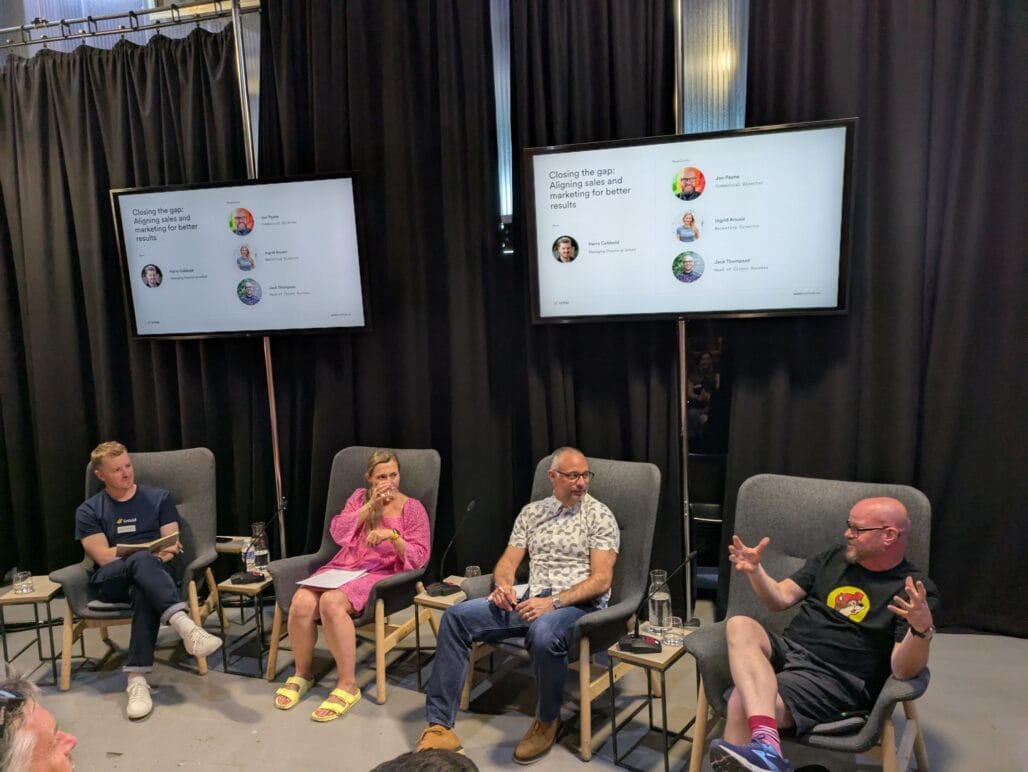We had a fantastic evening at our latest Smart Cookies event, “Closing the gap: Aligning sales and marketing for better results”. Hosted by our MD Harry, we were joined by an expert panel who explored how to effectively align your sales and marketing strategies for maximum growth.
Read on for a detailed summary and actionable insights into how to enhance your business’s sales and marketing performance.
Meet our expert panel
Ingrid Anusic, Marketing Director
As a B2B Marketing Director with 14 years in fintech including Moneyhub, NMI and Creditcall, Ingrid helps start-ups scale by enhancing brand visibility and credibility, fostering partnerships and driving growth, both digitally and face-to-face.
Jon Payne, Commercial Director
Jon Payne is the go-to Commercial Director or VP of RevOps – depending on how much his clients enjoy American job titles. He helps ambitious businesses across manufacturing, software, events and the arts unlock profit through creativity, process, and automation. With 30 years of experience running his own businesses – including Noisy Little Monkey, a renowned SEO and HubSpot agency.
Jack Thompson, Head of Client Success
Jack is Head of Client Success for independent software development company Ghyston, with 19 years experience of consulting at C level in organisations from startups through to global corporations.Jack believes that Karma applies to business as much as it does to life in general. This means he shares his knowledge and time to help others wherever he can.

Image credit: Jenny Grinsted
Insights
- B2B marketing is a marathon not a sprint
- Redefine success, then select the tech to match
- A flawed business strategy can derail even the best sales and marketing efforts
- Find the internal “champion” who can drive decisions
- Maintain presence during times of economic uncertainty
- AI is helping, but we will always need the human touch
B2B marketing is a marathon not a sprint
Ingrid explains how B2B marketing should be seen as a “marathon, not a sprint”. B2B sales cycles are long, often 12 months to 5 years, so quick wins are rare. In marketing you must play the long game as only a small portion of the market is ready to buy (around 5% of potential buyers are in-market at any one time). This highlights the need for continual brand awareness to make sure you are front of mind for when the other 95% are ready.
Another consideration, as Jack explains, is that sales and marketing can’t just “flip a switch” to generate immediate results. Strategies take time to prove, especially in outbound, success requires time and persistence. Jack highlighted the importance of managing expectations internally, setting clear KPIs, and understanding that building relationships and trust takes time.
In order to show progress we need to understand the customer journey and measure touchpoints. Jon suggested working with leadership to identify typical conversion points and creating metrics that can predict future sales potential. The key is showing progress through measurable intermediate steps, even if they don’t immediately translate to revenue.
The sales process is complex and consultative, involving multiple stakeholders so can’t be compared to transactional sales. As Ingrid points out, “we’re not selling Mars bars”. Ultimately we need patience, clear communication, and established metrics that show progress towards long-term sales goals, rather than expecting instant results.
Redefine success, then select the tech to match
Jack explained how the misalignment in how success is measured is a key challenge. Marketing teams might celebrate metrics like LinkedIn page likes or podcast listeners, while sales teams are focused on qualified leads. He emphasised the importance of having a shared understanding of success, using Ideal Customer Profiles (ICPs) to ensure both teams are targeting the right audience.
Jon pointed out the technological challenges, describing how many businesses use a “daisy chain of technology” with disconnected systems like spreadsheets, mailing lists, and various software platforms. He suggested taking a step back and aligning with senior leadership on what really drives value (whether that’s revenue or strategic goals). Then, identify the few essential tools or actions needed to achieve that, rather than trying to do everything. Simplify your tech stack by auditing for overlaps, and focus on systems that deliver the most impact efficiently.
A flawed business strategy can derail even the best sales and marketing efforts
Ingrid emphasised that a solid business strategy is crucial. We need to understand how revenue targets are set, ensuring market research has been conducted. She recommended strong collaboration between marketing, sales and product teams to align on how each team will contribute to the strategy and avoid situations where teams are working in silos
The solution lies in collaborative, research-driven strategic planning with clear roles and expectations for each team.
Find the internal “champion” who can drive decisions
Jack highlighted that decision-making is rarely done by a single person, even in B2C contexts. He referenced ‘The Challenger Customer’ book, suggesting the key is to find the person who actually “gets things done” – not necessarily the most senior person, but someone who can drive internal processes and make things happen. A key strategy for identifying the ‘Challenger customer’ is to give them specific homework after a call/meeting. If they complete it on time and as agreed (or even do more than requested) then it is a strong signal that you’re dealing with a proactive, “get-things-done” type of customer who is likely to move a project forward effectively.
This method provides a practical, low-stakes way to assess a potential customer’s commitment and ability to drive internal processes.
Jon agreed with this and suggested asking prospects – “Who else is going to be affected by this decision?”. This approach helps uncover other stakeholders more effectively than directly asking who’s involved in the decision making process. When you get the answer to this question you can then use this information to expand the conversation, positioning yourself as a trusted advisor who wants to ensure the solution works for everyone involved.
Ingrid recommended digging into existing customer data to understand typical job titles and decision-makers, and also recognise that different decision-makers have different pain points. You can then use this understanding to create targeted marketing campaigns for each stakeholder
Maintain presence during times of economic uncertainty
Jon emphasised that in a slower market where customers have less cash, they will be more focused on value. Businesses are increasingly looking to demonstrate the most value for their money. The key is to adjust our messaging to clearly show the tangible benefits and return on investment.
Ingrid explained how we should continue brand-building efforts, as staying memorable is crucial. Leveraging customer success stories and maintaining presence and visibility, even during economic downturns is key.
Jack agreed that we should do more marketing and sales activities and increase proactivity during challenging economic times. Highlighting your value beyond just cost by showcasing additional credentials like diversity, reliability, and quality is key.
AI is helping, but we will always need the human touch
When looking ahead to the next year and the main trends we’ll see in sales and marketing, all our panellists agreed that AI will have a big role to play. Jack highlighted how tools such as Fathom and Madam are great for call recording and follow ups, but explained that when it comes to direct customer interaction (especially qualification calls) a sales person is definitely still necessary.
Ingrid explained how AI is helping her complete tasks in a matter of days, that previously took weeks, but stressed the importance of maintaining human connection. There are areas of marketing where human interaction is critical, such as round tables and webinars.
The potential with AI is exciting however, the relationship building aspects of sales and marketing will always benefit from the human touch.
Additional resources and tools
The Challenger Sale and its follow-up, The Challenger Customer, offer proven frameworks for navigating complex B2B sales. These books emphasise finding a “champion” inside the client organisation who will push for change.
Tips from our panellists on choosing the right tools
- Choose tools based on your specific business needs
- Ensure you have expertise to maximise their potential
- Be cautious of over-investing in software
- Look for tools that can provide actionable insights
Hubspot – CRM and inbound marketing.
Salesforce – Advanced B2B automation.
Lead Forensics – Tracks anonymous website visitors.
Dripify – LinkedIn automation.
Mailchimp – Simple marketing for early-stage.
Lovable – AI to auto-import documents into CRM.
A huge thank you to Agilebase and BI Foresight for sponsoring this event. We’d love to see you at our next Smart Cookies evening, find out more here.

